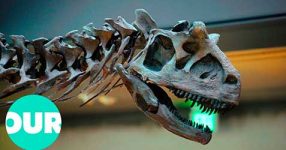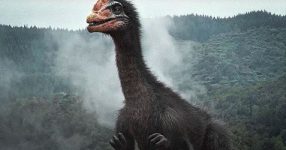The documentary “The “Tyrannosaurus” of Tambach-Dietharz” embarks on a captivating journey, delving into the mysteries of ancient life in what is now Thuringia, central Germany. Set against a backdrop of stone narratives, the story unfolds millions of years ago and extends into the present day. This visual exploration is guided by the seasoned paleontologist Thomas Martin, passing the torch to his successor, Tom Huebner, as they navigate the Bro Mocker quarry.
Thomas Martin, a veteran with four decades of Earth’s excavation, introduces the unique Bro Mocker quarry, a fossil site near the town of Tombak Detox Patna. Initially deemed an improbable location for body fossils, Martin challenged academic consensus by uncovering a bone in 1974. This unexpected find shattered beliefs, leading to the revelation that lower Permian fossils could indeed be found in the reddish-brown fine-grain rocks of Bro Mocker.
Geological Beginnings: Primitive Tetrapods and the Bro Mocker Footprint
The documentary takes us back to the end of the 19th century when a primitive tetrapod’s footprint was serendipitously found in the Bro Mocker quarry. This discovery triggered a series of excavations, uncovering the tracks and skeletons of ancient creatures. The initial skepticism surrounding finding body fossils in such conditions was challenged by Thomas Martin’s groundbreaking discoveries, revolutionizing the understanding of pre-dinosaur life.
The journey into Thuringia’s paleontological history leads us to Badly Ben Stein, where the discovery of proto-Soros, a primitive reptile, occurred in 1733. This significant finding, initially misunderstood, marked a turning point in scientific understanding, challenging the prevailing notion that shapes within rocks were random. The fossils from this region contribute to unraveling the Earth’s history over 300 million years.
Tracing Evolution: Hands Beasts and Early Amphibians
The documentary explores the enigmatic “Hands Beasts,” creatures leaving behind hand-shaped prints that puzzled 19th-century scientists. Through meticulous research, the tracks are deciphered, revealing the ancestors of crocodiles with a fluid gait. This revelation provides a snapshot into the evolutionary journey, reconstructing the Earth’s history and the emergence of early amphibians.
In the drawers of museums’ archives, the Earth’s history lies preserved in the form of fossilized skeletons. Discoveries like Lilyan Stano’s neo-theropod, a carnivore from the Triassic period, add layers to the narrative. The documentary showcases primitive amphibians, offering a glimpse into the Lord Lenient or Sis Aurelion epoch, highlighting the intricate details of these ancient creatures’ lives.
Unveiling Ancient Catastrophes: Floods and Mudslides
The excavation site near Tombak Detox reveals evidence of a catastrophic flood 285 million years ago. Periods of drought and monsoon rains in the region led to mudslides, trapping tetrapods and preserving their remains. The fossils found, such as the genus Assamoria, shed light on the harsh environmental conditions and provide a glimpse into Earth’s climatic fluctuations.
Despite the excavation site’s temporary closure in 2010, a group of researchers in Berlin expresses interest in resuming the dig at Bro Mocker. The combination of tracks, track makers, and exceptionally well-preserved skeletons makes this site unique. The documentary emphasizes the importance of continuing research to uncover more about the Earth’s history and its prehistoric inhabitants.
Technological Advancements: From Fossils to Robotics
The documentary introduces the technological aspect of the research, where Professor Enya Keturah and his team use digitization and animation to reconstruct the mobility of ancient creatures. The movement analysis challenges previous estimations, suggesting that effective mobility on land evolved earlier than thought, shifting the timeline back by 15 to 20 million years.
The exploration extends beyond fossils to cutting-edge robotics, showcasing a walking machine designed to mimic the motion of ancient creatures. With 28 motors controlling the complete movement, the machine demonstrates the complexity of prehistoric locomotion. Professor Enya Keturah’s project emphasizes the intersection of paleontology and technology, unlocking new perspectives on Earth’s ancient inhabitants.
Bridging Continents and Embracing the Past
As the documentary “The “Tyrannosaurus” of Tambach-Dietharz” concludes, it highlights the significance of fossil discoveries in connecting continents. The Tombaugh Flippers, a biological testament to the supercontinent Pangea, symbolize the interwoven history of Europe and North America. The rich fossil record from Thuringia unravels tales of ancient creatures, adding layers to the Earth’s evolutionary story. The quest for knowledge and the anticipation of future excavations continue, promising further revelations from the depths of time.












